Dynamic Mechanical Properties of Slag Mortar with Alkali-Resistant Glass Fiber
Abstract
:1. Introduction
2. Experiments and Methods
2.1. Materials
2.2. Mix Proportion and Sample Preparation
2.3. Experimental Equipment and Methods
3. Results and Discussions
3.1. The Relationship between Fiber Content and Static Compressive Strength of SCM
3.2. The Influence of Fiber Incorporation on the Dynamic Stress–Strain Curve of SCM
3.3. Effect of Fiber Content on Dynamic Mechanical Properties of SCM
3.4. Microstructure Analysis of Alkali-Resistant Glass Fiber SCM
4. Conclusions
- The incorporation of alkali-resistant glass fiber into SCM promoted the impact resistance of SCM. The static pressure resistance strength of SCM was found be proportional to the amount of alkali-resistant glass fiber.
- The static pressure resistance strength of mortars had a negative relationship with fiber content when the fiber content exceeded 0.75%, where G0.75 showed the best performance from the aspects of dynamic compressive strength and ultimate toughness in the strain rate range of 75.03 s−1~141.47 s−1. Furthermore, its DIF had a good representation as the range increases.
- The bonding performance between alkali-resistant glass fiber and cement matrix was strong, and the fibers were interlaced in the mortar to form a network structure, which had a good effect on toughening and strengthening the SCM.
Author Contributions
Funding
Institutional Review Board Statement
Informed Consent Statement
Data Availability Statement
Acknowledgments
Conflicts of Interest
References
- Liu, L.; Zhou, A.; Deng, Y.; Cui, Y. Strength performance of cement/slag-based stabilized soft clays. Constr. Build. Mater. 2019, 211, 909–918. [Google Scholar] [CrossRef]
- Yuan, P.; Gong, L.M. Analysis of mechanics performance impact about fibrous material to gangue active powder concretes. Concrete 2009, 12, 58–60. [Google Scholar]
- Fan, F.L.; Xu, J.Y.; Li, W.M.; Yang, J.Y.; Zhai, Y. Impact mechanical properties of slag-and fly ash-based geopolymer concrete. Explos. Shock. Waves 2009, 29, 516–522. [Google Scholar]
- Xie, Y.L.; Zhao, L.; Zhang, Y. Research on the impact resistance properties of polyvinyl alcohol and polypropylene fiber concrete. Concrete 2017, 8, 70–73. [Google Scholar]
- Rostami, R.; Zarrebini, M.; Mandegari, M.; Sanginabadi, K.; Mostofinejad, D.; Abtahi, S.M. The effect of concrete alkalinity on behavior of reinforcing polyester and polypropylene fibers with similar properties. Cem. Concr. Compos. 2018, 97, 118–124. [Google Scholar] [CrossRef]
- Zhang, L.F.; Liang, Q.S.; Yin, Y.L. Research on the performance of polypropylene fiber reinforced alkali SCM. Concr. Cem. Prod. 2014, 11, 60–63. [Google Scholar]
- Amer, I.; Kohail, M.; Elfeky, M.; Rashad, M. Evaluation of Using Cement in alkali-activated slag concrete. Int. J. Sci. Technol. Res. 2020, 9, 245. [Google Scholar]
- Maharishi, A.; Singh, S.P.; Gupta, L. Strength and durability studies on slag cement concrete made with copper slag as fine aggregates. Mater. Today 2020, 38, 15–25. [Google Scholar] [CrossRef]
- Dong, Z.F. Research on Service Performance of Alkali-Resistant Cluster Glass Fiber Concrete and Polypropylene Geotextile. Master’s Thesis, Beijing University of Technology, Beijing, China, 2018. [Google Scholar]
- Yue, L.F.; Li, D.X. Influences of Caustic-Resisting Glass Fiber to Mechanical Properties of Set Oil Well Cement Blended with Mineral Slag. Drill. Fluids Completion Fluids 2006, 23, 62–65. [Google Scholar]
- Martin, T.; Taylor, S.; Robinson, D.; Cleland, D. Arching in concrete slabs strengthened with near surface mounted fiber reinforced polymers. Eng. Struct. 2019, 184, 257–277. [Google Scholar] [CrossRef] [Green Version]
- Gao, N.; Yu, G.Q.; Zhao, Y.L.; Xue, Z.H.; He, W.M. Research on modified cement mortar mixed with glass fiber and polymer. Concr. Cem. Prod. 2016, 3, 53–57. [Google Scholar]
- Wu, F.N. Research on Preparation of Alkali-Resistant Glass Fibers from Industrial Wastes Such as Blast Furnace Slag. Master’s Thesis, University of Jinan, Jinan, China, 2016. [Google Scholar]
- Dong, J.M.; Nie, H.; Yan, Y.J. Study on mechanical properties of sisal fiber reinforced self-compacting lightweight aggregate concrete. New Build. Mater. 2016, 8, 89–91. [Google Scholar]
- Deng, Z.C.; Dong, Z.F. Impact Mechanical Properties of Fiber Reinforced Concrete Slab with Alkali-Resistant Glass Fiber of High Zirconium. J. Tianjin Univ. Nat. Sci. Eng. Technol. Ed. 2018, 51, 66–74. [Google Scholar] [CrossRef]
- Chen, Y.Z.; Tian, C.J.; Chen, G.; Li, S.Z. Analysis of the inertial effect of the cylindrical specimen in SHPB system. Chin. J. Solid Mech. 2005, 1, 107–110. [Google Scholar]
- ASTM C109, C109M–16a; Standard Test Method for Compressive Strength of Hydraulic Cement Mortars. ASTM International: West Conshohocken, PA, USA, 2016.
- Yu, T.X.; Qiu, X.M. Impact Dynamics; Tsinghua University Press: Beijing, China, 2011; pp. 63–65. [Google Scholar]
- Lu, M.; Xiao, H.; Liu, M.; Li, X.; Li, H.; Sun, L. Improved interfacial strength of SiO2 coated carbon fiber in cement matrix. Cem. Concr. Compos. 2018, 91, 21–28. [Google Scholar] [CrossRef]
- Li, M.; Mao, X.B.; Cao, L.L.; Rong-Rong, M.A.; Hai, P.U. Experimental study on mechanical properties of coal under high strain rate. J. Min. Saf. Eng. 2015, 2, 317–324. [Google Scholar]
- Gao, Q.; Wang, H.B.; Lv, N.; Zong, Q. Experimental study on mechanical characteristics of hard coal under different impact velocities. China Saf. Sci. Technol. 2019, 15, 69–74. [Google Scholar]
- Deng, Z.C.; Xue, H.Q.; Zhang, P.F.; Li, P.Y.; She, X.J. Research on Flexural Impact Behavior of Alkali-Resistance Glass Fibers Reinforced Concrete. Highway 2007, 12, 184–187. [Google Scholar]
- Yuan, S.J. Study on Collapse Failure Mechanism of Concrete Girder Bridge under Explosion Load. Ph.D. Thesis, Southeast University, Nanjing, China, 2019. [Google Scholar]
- Sun, X.; Zhao, K.; Li, Y.; Huang, R.; Ye, Z.; Zhang, Y.; Ma, J. A study of strain-rate effect and fiber reinforcement effect on dynamic behavior of steel fiber-reinforced concrete. Constr. Build. Mater. 2018, 158, 657–669. [Google Scholar] [CrossRef]
- Tian, Z.H.; Jiang, G.L.; Su, W.H.; Ni, J. Dynamic compressive properties of fiber mortar subjected to impact load. J. Vib. Shock. 2018, 37, 90–95. [Google Scholar]
- Liang, N.H.; Yang, P.; Liu, X.R.; Zhang, Y.; Guo, Z.Q. A Study on Dynamic Compressive Mechanical Properties of Multi-Size Polypropylene Fiber Concrete Under High Strain Rate. Mater. Rev. 2018, 32, 288–294. [Google Scholar]
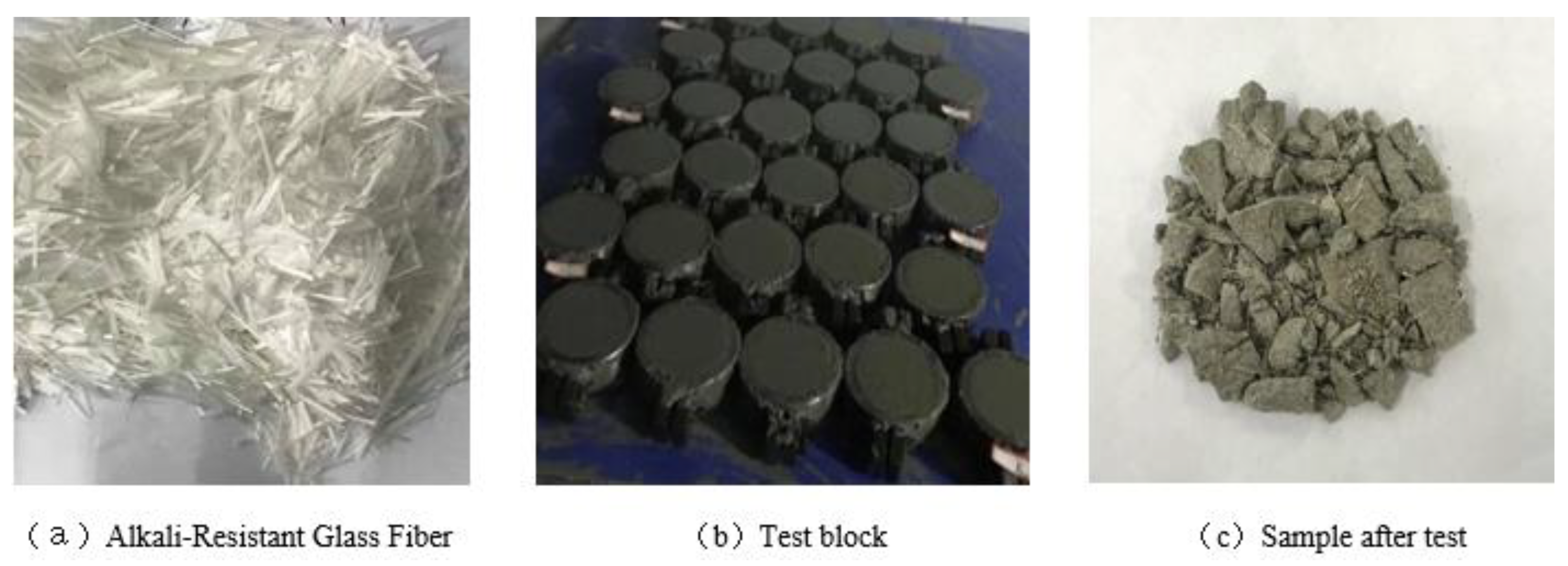

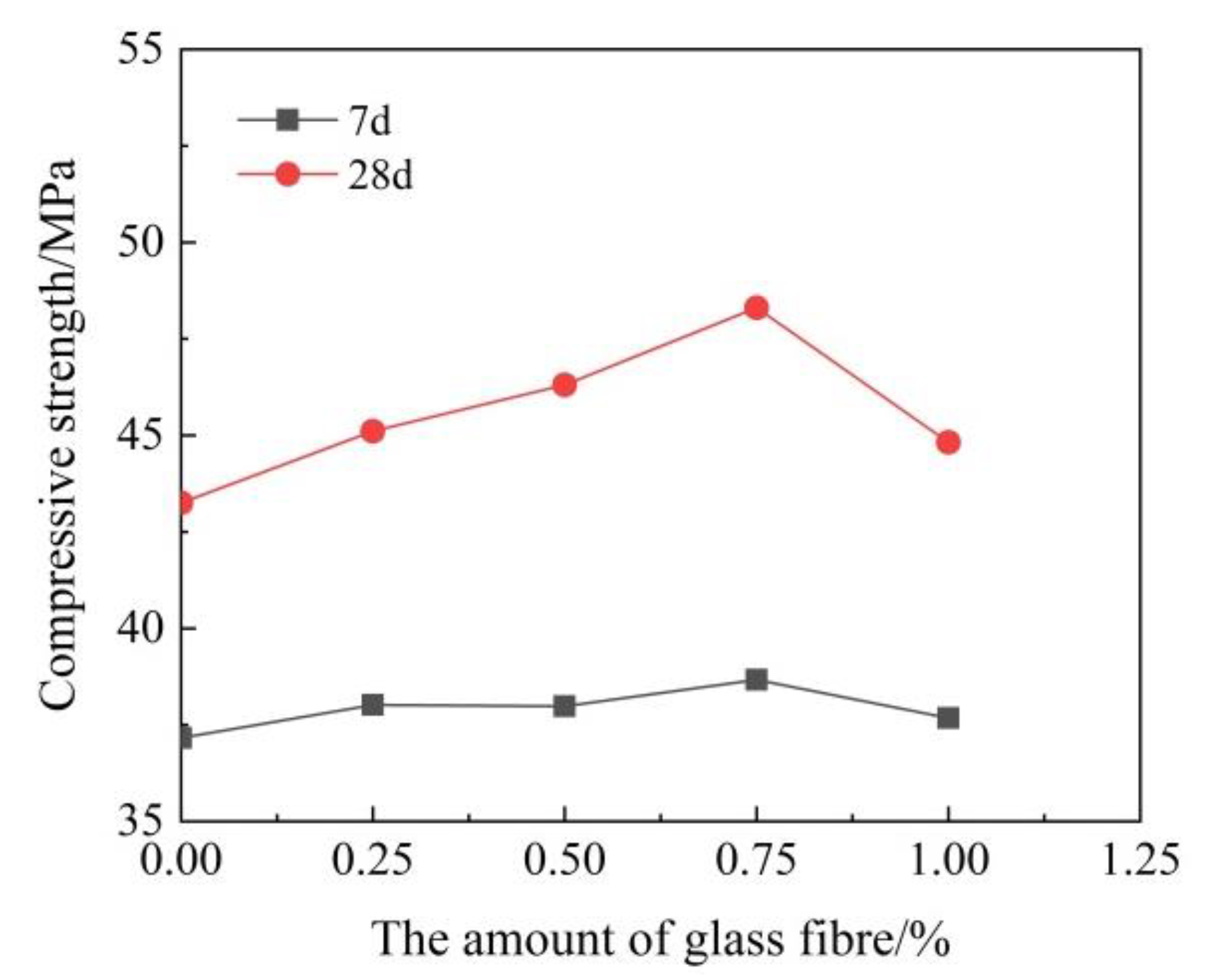
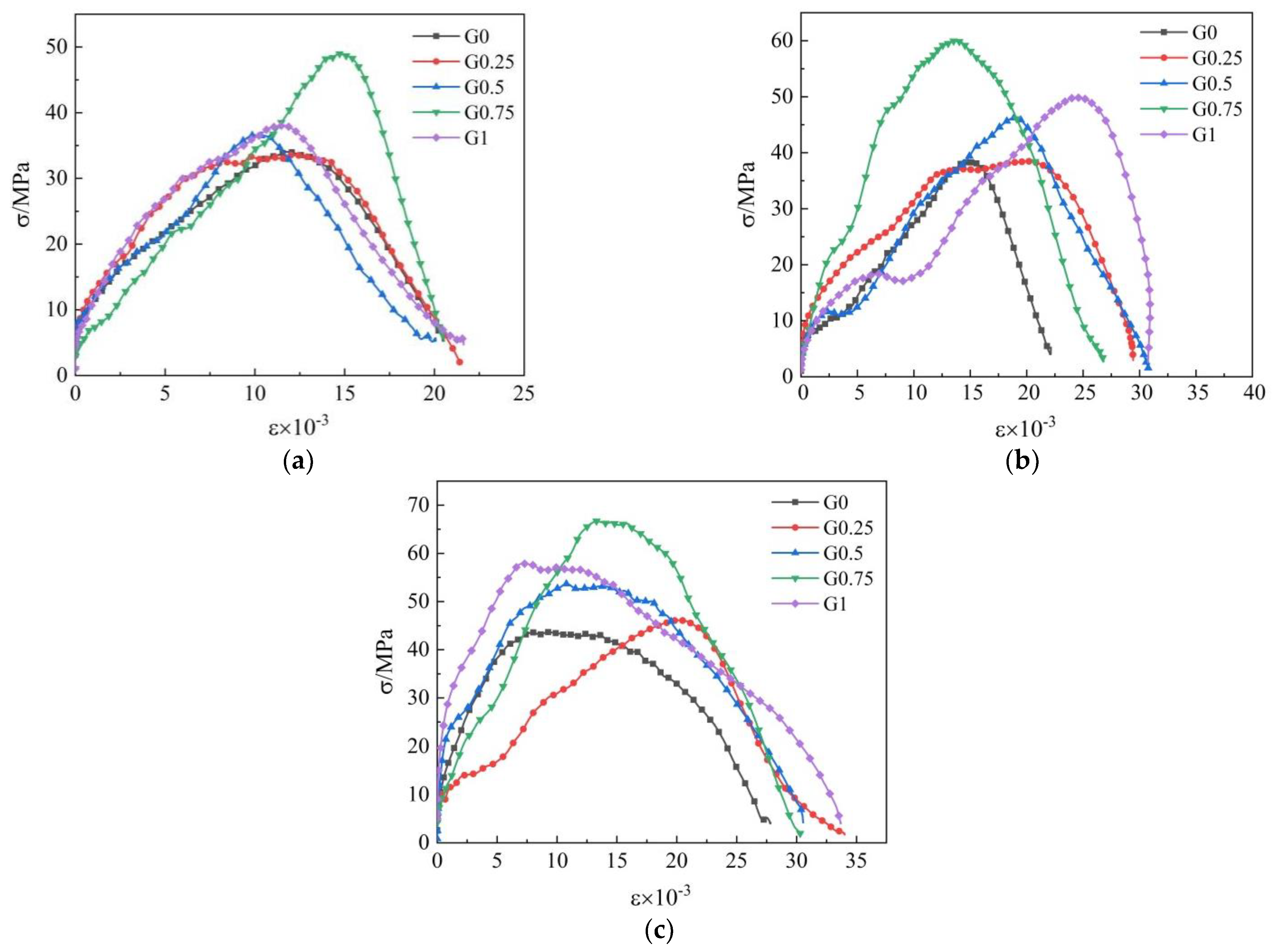
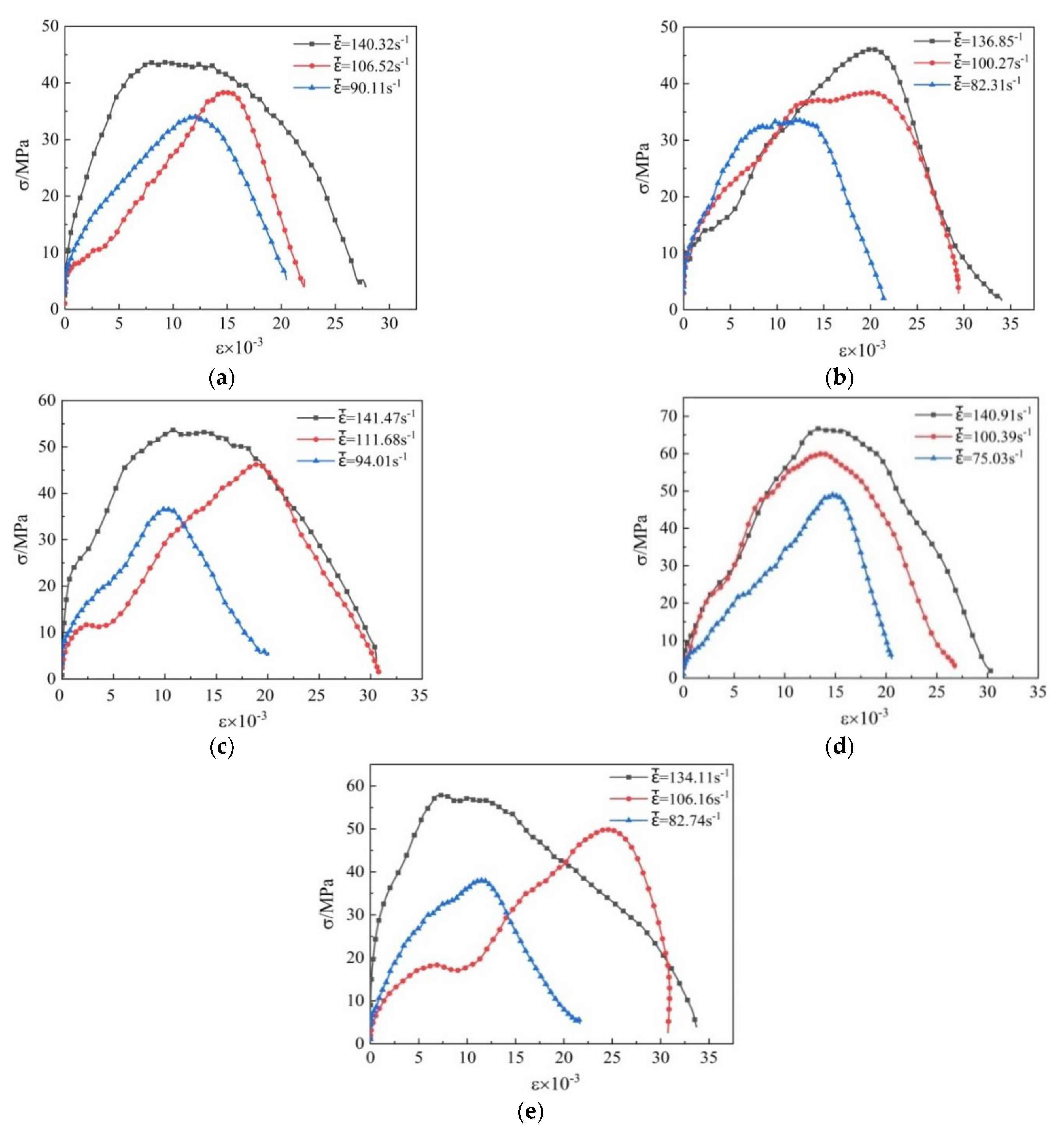

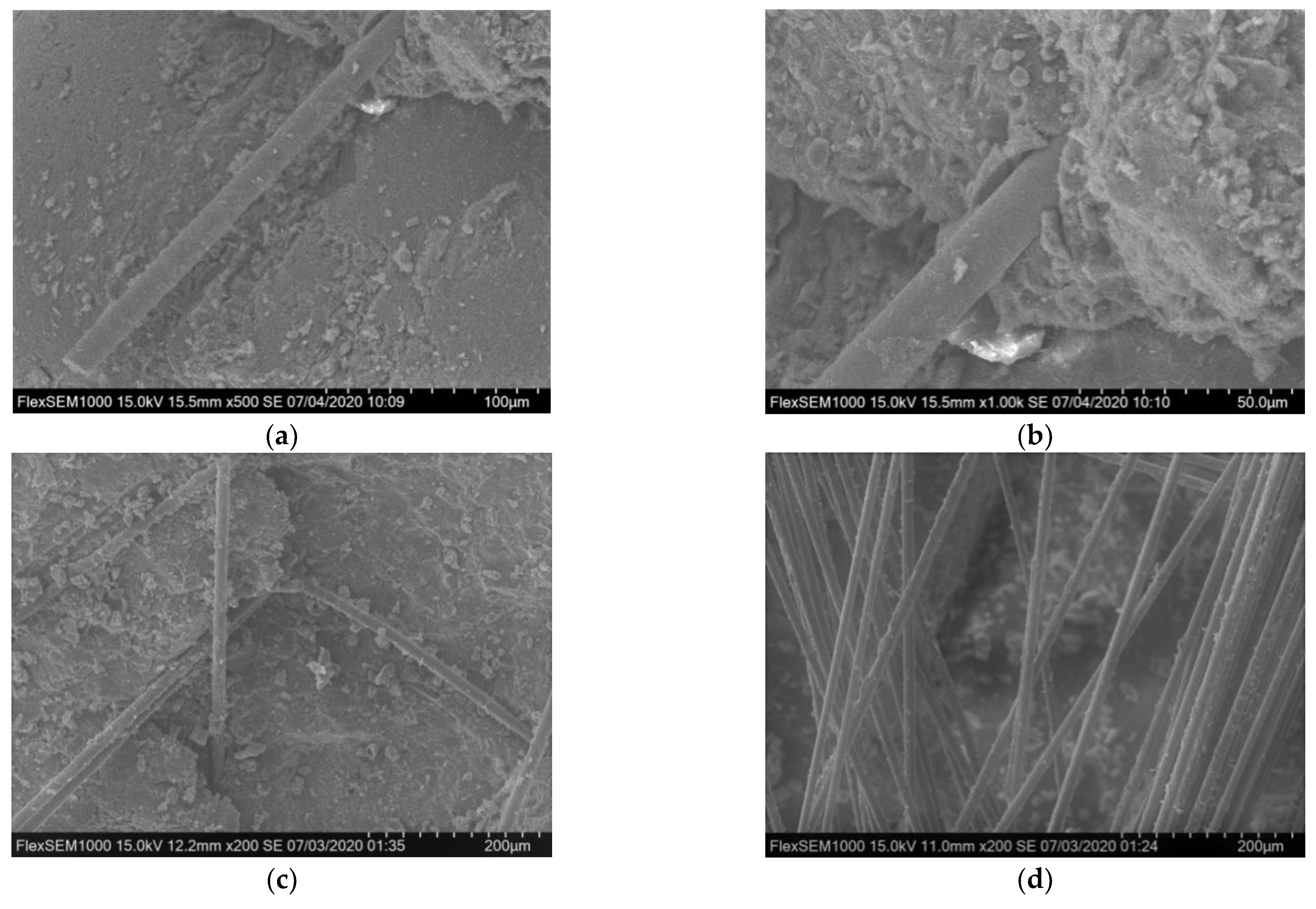
| Length/mm | Diameter/μm | Density/(g/cm3) | Modulus of Elasticity/GPa | Tensile Strength/MPa |
|---|---|---|---|---|
| 12 ± 2 | 14 | 2.68 | 72 | 1800 |
| Mixtures | Fiber Content by Volume/% | Material (kg/m3) | |||
|---|---|---|---|---|---|
| Cement | Water | Sand | Slag | ||
| G0 | 0 | 291.6 | 145.8 | 510.3 | 72.9 |
| G0.25 | 0.25 | 291.6 | 145.8 | 510.3 | 72.9 |
| G0.5 | 0.5 | 291.6 | 145.8 | 510.3 | 72.9 |
| G0.75 | 0.75 | 291.6 | 145.8 | 510.3 | 72.9 |
| G1 | 1 | 291.6 | 145.8 | 510.3 | 72.9 |
| Mix Number | Code | Statistic Compressive Strength/MPa | Peak Stress/MPa | DIF | Ultimate Strain | Impact Air Pressure/MPa | ||
|---|---|---|---|---|---|---|---|---|
| G0-1 | 90.11 | 34.050 | 0.785 | 0.4743 | 0.0205 | 0.3 | ||
| G0 | G0-2 | 43.350 | 106.52 | 38.326 | 0.884 | 0.4933 | 0.0221 | 0.4 |
| G0-3 | 140.32 | 43.649 | 1.007 | 0.8932 | 0.0278 | 0.5 | ||
| G0.25-1 | 82.31 | 33.838 | 0.752 | 0.5150 | 0.0214 | 0.3 | ||
| G0.25 | G0.25-2 | 45.019 | 100.27 | 38.460 | 0.854 | 0.8347 | 0.0294 | 0.4 |
| G0.25-2 | 136.85 | 46.112 | 1.024 | 0.9035 | 0.0340 | 0.5 | ||
| G0.5-1 | 94.01 | 36.593 | 0.792 | 0.4351 | 0.0201 | 0.3 | ||
| G0.5 | G0.5-2 | 46.206 | 111.68 | 46.243 | 1.001 | 0.8004 | 0.0305 | 0.4 |
| G0.5-3 | 141.47 | 53.672 | 1.162 | 1.1748 | 0.0308 | 0.5 | ||
| G0.75-1 | 75.03 | 48.973 | 1.016 | 0.5682 | 0.0205 | 0.3 | ||
| G0.75 | G0.75-2 | 48.176 | 100.39 | 59.965 | 1.245 | 1.0062 | 0.0268 | 0.4 |
| G0.75-3 | 140.91 | 66.699 | 1.384 | 1.2660 | 0.0303 | 0.5 | ||
| G1-1 | 82.74 | 38.062 | 0.849 | 0.5149 | 0.0216 | 0.3 | ||
| G1 | G1-2 | 44.819 | 106.16 | 49.843 | 1.112 | 0.9180 | 0.0308 | 0.4 |
| G1-3 | 134.11 | 57.860 | 1.291 | 1.2393 | 0.0337 | 0.5 |
Publisher’s Note: MDPI stays neutral with regard to jurisdictional claims in published maps and institutional affiliations. |
© 2022 by the authors. Licensee MDPI, Basel, Switzerland. This article is an open access article distributed under the terms and conditions of the Creative Commons Attribution (CC BY) license (https://creativecommons.org/licenses/by/4.0/).
Share and Cite
Ma, H.; Yang, S.; Xu, Y.; Chen, P.; Wang, L. Dynamic Mechanical Properties of Slag Mortar with Alkali-Resistant Glass Fiber. Buildings 2022, 12, 266. https://doi.org/10.3390/buildings12030266
Ma H, Yang S, Xu Y, Chen P, Wang L. Dynamic Mechanical Properties of Slag Mortar with Alkali-Resistant Glass Fiber. Buildings. 2022; 12(3):266. https://doi.org/10.3390/buildings12030266
Chicago/Turabian StyleMa, Haibin, Shaofan Yang, Ying Xu, Peiyuan Chen, and Liang Wang. 2022. "Dynamic Mechanical Properties of Slag Mortar with Alkali-Resistant Glass Fiber" Buildings 12, no. 3: 266. https://doi.org/10.3390/buildings12030266
APA StyleMa, H., Yang, S., Xu, Y., Chen, P., & Wang, L. (2022). Dynamic Mechanical Properties of Slag Mortar with Alkali-Resistant Glass Fiber. Buildings, 12(3), 266. https://doi.org/10.3390/buildings12030266






